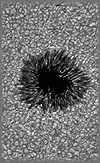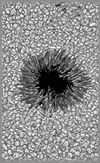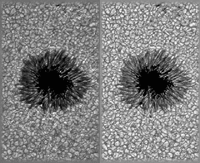Penumbral and
Photospheric Features
Phase diversity restoration of sunspot
images. I. Relations between penumbral and photospheric features
by
Bonet, J. A., Márquez, I., Muller, R., Sobotka, M. and Tritschler, A.
( PDF - PS )
ABSTRACT:
We investigate the dynamics of and the relations between small-scale
penumbral and photospheric features near the outer penumbral boundary:
penumbral grains (PGs), dark penumbral fibrils, granules, and
photospheric G-band bright points. The analysis is based on a 2 h time
sequence of a sunspot close to disc center, taken simultaneously in the
G-band and in the blue continuum at 450.7 nm. Observations were
performed at the Swedish Vacuum Solar Telescope (La Palma) in July
1999.
A total of 2564 images (46 arcsec × 75 arcsec) were corrected for
telescope aberrations and turbulence perturbations by applying the
inversion method of phase diversity. Our findings can by summarized as
follows: (a) one third of the outward-moving PGs pass through the outer
penumbral boundary and then either continue moving as small bright
features or expand and develop into granules. (b) Former PGs and G-band
bright points next to the spot reveal a different nature. The latter
have not been identified as a continuation of PGs escaping from the
penumbra. The G-band bright points are mostly born close to dark
penumbral fibrils where the magnetic field is strong, whereas PGs stem
from the less-magnetized penumbral component and evolve presumably to
non-magnetic granules or small bright features.
Phase diversity restoration of sunspot
images. II. Dynamics around a decaying sunspot
ABSTRACT:
Two time series, taken simultaneously in the G-band and in white-light,
and corrected for telescope aberrations and turbulence perturbations
using the method of phase diversity, are employed to study the motions
of granules and G-band bright points (GBPs) in the moat of an old
regular sunspot. Local correlation tracking and feature tracking have
been utilized for this purpose. A large-scale radial outflow with a
mean
velocity of 0.51 km s-1 has been measured in the sunspot
moat. Centres of diverging horizontal motions, identified with families
of granules formed by repeatedly splitting granules, move away from the
sunspot. Most of the GBPs in the moat also move outwards through
radially orientated ``channels'' (confined between the borders of
adjacent families) with velocities comparable to those of the adjacent
granules. However, 6% of the GBPs move faster (>1.4 km
s-1) than the neighbouring granules. GBPs in the moat are
not
regularly distributed but they are less frequent on its solar centre
side.
MOVIES:
7 Jul. 1997 Sunspot NOAA 8620, at µ=0.93.
SVST, Observatorio del Roque de los Muchachos (La Palma) (*)
Phase diversity reconstructed data. Subsonic filtered movies
7:30 UT, 120 min (cadence 25 s)
area 46’’x75’’ (560x910 pix) 0.083 arcsec per píxel
*The Swedish Vacuum Solar Telescope was operated on the island of La
Palma by the Royal Swedish Academy of Sciences in the Spanish
Observatorio del Roque de los Muchachos of the Instituto de
Astrofísica de Canarias.
The movies are in the .avi format, and generated using the
Microsoft MPEG-4, V2 codecs MPEG-4
Microsoft page. Their size is 768 x 576 pixels, their duration is
11 seconds.
|


